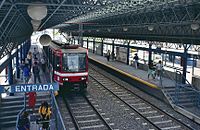 Light rail car at Unidad Deportiva station on the Guadalajara light rail system, the busiest LRT system in North America
Light rail car at Unidad Deportiva station on the Guadalajara light rail system, the busiest LRT system in North America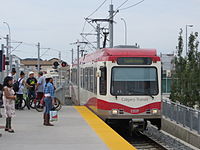 Calgary's CTrain is North America's second-busiest LRT system
Calgary's CTrain is North America's second-busiest LRT system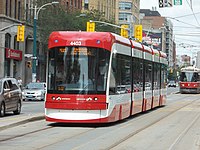 The Toronto streetcar system is the third-busiest LRT system in North America with 8 routes in mixed traffic and 3 in reserved lanes
The Toronto streetcar system is the third-busiest LRT system in North America with 8 routes in mixed traffic and 3 in reserved lanes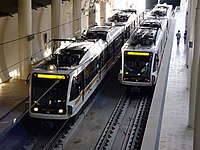 Los Angeles Metro L Line trains in Pasadena, California, North America's fifth-busiest LRT system
Los Angeles Metro L Line trains in Pasadena, California, North America's fifth-busiest LRT system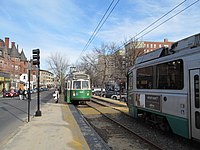 Light rail vehicles on Boston's Green Line, the sixth-busiest light rail system
Light rail vehicles on Boston's Green Line, the sixth-busiest light rail system
Light rail is a commonly used mode of public transit in North America. The term light rail was coined in 1972 by the Urban Mass Transportation Administration (UMTA; the precursor to the U.S. Federal Transit Administration) to describe new streetcar transformations which were taking place in Europe and the United States. The Germans used the term Stadtbahn, which is the predecessor to North American light rail, to describe the concept, and many in UMTA wanted to adopt the direct translation, which is city rail. However, in its reports, UMTA finally adopted the term light rail instead.
History of streetcars and light rail
See also: Streetcars in North AmericaFrom the mid-19th century onwards, horse-drawn trams or horsecars were used in cities around the world. In the late 1880s electrically powered street railways became technically feasible following the invention of a trolley pole system of collecting current by American inventor Frank J. Sprague who installed the first successful system at Richmond, Virginia. They became popular because roads were then poorly surfaced, and before the invention of the internal combustion engine and the advent of motor-buses, they were the only practical means of public transport around cities.

The streetcar systems constructed in the 19th and early 20th centuries typically only ran in single-car setups. Some rail lines experimented with multiple unit configurations, where streetcars were joined together to make short trains. When lines were built over longer distances (typically with a single track) before good roads were common, they were generally called interurban streetcars or radial railways in North America.
After World War II, seven major North American cities (Boston, Newark, New Orleans, Philadelphia, Pittsburgh, San Francisco, and Toronto) continued to operate large streetcar systems. Some of these cities called their modernized systems light rail in an attempt to differentiate it from their existing streetcars particularly cities that continued to operate both the old and new systems. Cleveland, Ohio, maintained an interurban system (e.g. the Blue and Green Lines) that is equivalent to what is now "light rail", which opened before World War I, and which is still in operation to this day.
In North America, many of these original streetcar systems were decommissioned in the 1950s and onward as the usage of the automobile increased. Although some traditional trolley or tram systems still exist to this day, the term "light rail" has come to mean a different type of rail system. Modern light rail technology has primarily German origins, since an attempt by Boeing Vertol to introduce a new American light rail vehicle was a technical failure.
The renaissance of light rail in North American began in 1978 when the Canadian city of Edmonton, Alberta adopted the German Siemens-Duewag U2 system, followed three years later by Calgary, Alberta and San Diego, California.
Historically, the rail gauge has had considerable variations, with narrow gauge common in many early systems. However, most light rail systems are now standard gauge. An important advantage of standard gauge is that standard railway maintenance equipment can be used on it, rather than custom-built machinery. Using standard gauge also allows light rail vehicles to be delivered and relocated conveniently using freight railways and locomotives. Additionally, more manufacturers are able to produce standard gauge vehicles, reducing costs for rolling stock acquisition. Another factor favoring standard gauge is that low-floor vehicles are becoming popular, and there is generally insufficient space for wheelchairs to move between the wheels in a narrow gauge layout.
The use of a proof-of-payment fare collection system is standard practice on modern North American light rail systems, as it reduces the dwell time at stations by allowing passengers to board and alight at all doorways of a light rail vehicle (LRV) or train.
Diesel light rail
 eBART train approaching Pittsburg Center, operating in a dedicated right of way (May 2018)
eBART train approaching Pittsburg Center, operating in a dedicated right of way (May 2018) New Jersey River Line DMU, at a level crossing (April 2007)
New Jersey River Line DMU, at a level crossing (April 2007)
A few recently opened systems in North America use diesel multiple units, including: the Trillium Line in Ottawa (opened in 2001); the River Line in New Jersey (opened in 2004); Sprinter in northern San Diego County, California (opened in 2008); and eBART in eastern Contra Costa County, California (opened in 2018). Diesel operations are chosen in corridors where lower ridership is expected (and thus do not justify the expense of the electric power infrastructure) or which have an "interurban" nature with stations spaced relatively far apart (electric power provides greater acceleration, making it essential for operations with closely spaced stations). Operations with diesel-powered trains can be an interim measure until ridership growth and the availability of funding allow the system to be upgraded to electric power operations.
Ridership on light rail in North America
Main article: List of North American light rail systems by ridershipThe following table lists the fifteen light rail systems in North America with the highest riderships in 2023:
| City/metro area served | Country | Light rail system | Annual ridership (2023) | |
|---|---|---|---|---|
| 1 | Guadalajara | Mexico | SITEUR | 157,725,000 |
| 2 | Calgary | Canada | CTrain | 85,320,400 |
| 3 | Toronto | Canada | Toronto streetcar system | 69,106,000 |
| 4 | Los Angeles | United States | Los Angeles Metro Rail | 39,265,635 |
| 5 | San Diego | United States | San Diego Trolley | 38,438,116 |
| 6 | Boston | United States | Massachusetts Bay Transportation Authority | 33,875,783 |
| 7 | Seattle | United States | Link light rail | 26,867,751 |
| 8 | San Francisco | United States | Muni Metro | 26,508,038 |
| 9 | Mexico City | Mexico | Xochimilco Light Rail | 25,143,000 |
| 10 | Edmonton | Canada | Edmonton LRT | 24,143,200 |
| 11 | Portland, Oregon | United States | MAX Light Rail | 23,395,460 |
| 12 | Dallas | United States | Dallas Area Rapid Transit (DART) | 21,380,930 |
| 13 | Minneapolis-Saint Paul | United States | Metro Transit (Minnesota) | 14,755,893 |
| 14 | Jersey City, New Jersey | United States | NJ Transit | 14,583,233 |
| 15 | Houston | United States | Houston Metro | 13,883,712 |
In general, ridership on light rail systems in Mexico and Canada tends to be higher than the corresponding ridership on light rail systems in the United States, especially on a boardings per mile basis where the Mexican systems (Guadalajara light rail system and Xochimilco Light Rail) rank first and second, and three Canadian systems (Calgary's CTrain, Edmonton LRT and Toronto's streetcars) rank third, fifth and seventh. On a boardings per mile basis, the most ridden light rail systems in the United States are again Boston's MBTA ranked sixth, followed by San Francisco's Muni Metro ranked eighth.
Light rail in Canada
Main article: Urban rail transit in Canada| Location | System | Year opened | System length | Stations | Lines | Latest expansion | Type |
|---|---|---|---|---|---|---|---|
| Calgary | CTrain | 1981 | 59.9 km (37.2 mi) | 45 | 2 | 2014 | Light rail |
| Edmonton | Edmonton LRT | 1978 | 24.3 km (15.1 mi) | 18 | 2 | 2015 | Light rail |
| Ottawa | O-Train | 2001 | 35.5 km (22.1 mi) | 25 | 3 | 2025 | Light rail |
| Toronto | Toronto streetcar system | 1861 | 82 km (51 mi) | 708 | 11 | 2016 | Streetcar |
| Waterloo Region | Ion LRT | 2019 | 19 km (12 mi) | 19 | 1 | n/a | Light rail |
Notes
- Toronto also has a metro / rapid transit system, in addition to its streetcar system. See List of metro systems.
In general, Canadian cities have rates of public transit use which are two to three times as high as comparably sized U.S. cities. Census data for 2016 show that 12.4% of Canadians use public transit to commute to work, compared to 5.4% of Americans. This means that transportation planners must allow for higher passenger volumes on Canadian transit systems than American ones.
As a result of lower government funding, Canadian cities have to recover a much higher share of their costs out of operating revenues. This lack of funding may explain why there is resistance to the high capital costs of rail systems and there are only a few light rail systems in Canada.
There are a number of LRT proposals in Canada, a few of which are under construction such as in Ottawa, Toronto and Waterloo Region (Ontario). These are described further in the main article.
Calgary
Main article: CTrainCalgary Transit claims that the Calgary CTrain network, which started operation in 1981, has the highest ridership of any modern light rail transit system in North America, carrying over 320,000 passengers per weekday. This is higher than the Toronto streetcar system that began operation in 1861 and is also higher than the Boston Light Rail system, which is the busiest light rail transit system in the United States. At present, there are 45 stations in operation along the 58.7-kilometer (36.5 mi) CTrain light rail system. There are four legs in the system radiating directionally out into the suburbs from the downtown core that are connected by shared tracks along a downtown transit mall. They have been organized into two CTrain lines (identified as the Red Line and the Blue Line on network maps). The legs, as built in chronological order, are the South (1981), the Northeast (1985), the Northwest (1987), and the West (2012). Route 201 (Red Line) connects the South and Northwest lines; Route 202 (Blue Line) connects the Northeast and West lines. The two routes share most of the downtown line on the 7th Avenue South transit mall; the exception is the Downtown West – Kerby station, which serves only Route 202. The planned Route 203 - Green line will add about 40 kilometres (25 mi) and 28 stations to the system by connecting a North leg to a Southeast leg, probably in a tunnel underneath the existing downtown transit mall. Construction on it is expected to start in 2017.
In late 2015, Calgary Transit started running four-car trains to alleviate congestion as the system exceed 300,000 passengers per weekday. The longer trains can carry 800 passengers per train compared to 600 on three-car trains, a 33% increase. This upgrade required rebuilding or relocating all 45 station platforms to accommodate the longer trains, and buying 63 new vehicles to add another car to each train. Trains will be lengthened as more vehicles are delivered from the manufacturer.
Edmonton
Main article: Edmonton LRT
Edmonton was the first city in North America to build a modern (second generation) light rail system. The route (today called the Capital Line) first started construction in 1974, and opened its first segment on April 22, 1978, in time for the 1978 Commonwealth Games. The Edmonton Transit System built much of its initial light rail system underground, which meant that it could not afford to lay as much track to the suburbs at the time of its opening. The system has grown incrementally since its opening, and as of 2010 had grown to a 21-kilometer (13 mi) long light rail line serving a total of 15 stations. The system is successful by North American standards, with an average weekday ridership of 93,600 passengers in 2010. The City of Edmonton has focused on LRT expansion plans since 2007. The Metro Line, a branch of the existing Capital Line, opened in September 2015. The separate Valley Line, under construction as of 2024, but with its first 13.1-kilometre (8.1 mi) phase opened in November 2023, uses low-floor vehicles.
Ottawa
Main article: O-TrainIn 2001, to supplement its bus rapid transit (BRT) system, Ottawa opened a diesel light rail pilot project, the O-Train, which was relatively inexpensive to construct (CA$21 million), due to its single-track route along a little used freight-rail right of way and use of diesel multiple units (DMUs) to avoid the cost of building overhead lines along the tracks.
With the construction of the Confederation Line, the O-Train brand has been extended to both rail transit services and the diesel line has been renamed as the Trillium Line. The Trillium Line is an 8 km (5.0 mi) diesel light rail line running north to south from Bayview Station to Greenboro Station connecting with a transitway at each terminus. There are three passing sidings along the single-track line. The Confederation Line is a light rail line that runs east-west from Blair to Tunney's Pasture connecting to a transitway at each terminus and with the Trillium Line at Bayview. The line runs both underground and on the surface. There is a tunnel downtown with three underground stations. As of 2020, the system is in Stage 2 construction to add 24 new stations on the east and west ends of the Confederation Line and to add new stations between existing ones. A south expansion on the Trillium Line is also being constructed. The Stage 2 project is set to be complete by 2026.
Toronto
Most of the 11 routes of the Toronto streetcar system operate in mixed traffic, but three of them (509 Harbourfront, 510 Spadina and 512 St. Clair) as well as a 3-kilometre (1.9 mi) portion of the 501 Queen in the median of The Queensway have similarity to light rail in that there is a high degree of separation from road traffic by using reserved lanes with some track in tunnels.
Waterloo Region
Main article: Ion rapid transitThe first phase of the 19-kilometre LRT system runs from Conestoga station in Waterloo to Fairway station in Kitchener. It opened to the public on June 21, 2019. Waterloo Region, Ontario has also approved plans for a light rail extension to the Ainslie St. Transit Terminal in Cambridge, as phase two of Ion. The Kitchener to Cambridge segment will be operated as adapted bus rapid transit.
Light rail in Mexico
| Location | System | Year opened | System length | Stations | Lines | Latest expansion | Type |
|---|---|---|---|---|---|---|---|
| Guadalajara | Sistema de Tren Eléctrico Urbano | 1989 | 45.5 km (28.3 mi) | 48 | 3 | 2020 | Light rail |
| Mexico City | Xochimilco Light Rail | 1986 | 12.8 km (8.0 mi) | 18 | 1 | 1995 | Light rail |
Notes
- Mexico City also has a metro/rapid transit system, in addition to its light rail system - see the List of metro systems.

There are two light rail systems in Mexico: Guadalajara's, and Mexico City's Xochimilco Light Rail line (known locally as el Tren Ligero). A third system, Monterrey's Metrorrey also has some characteristics of a light rail system (especially in its use of high-floor light rail vehicles), but runs in a fully grade separated, exclusive right-of-way with high passenger volumes, which are generally the criteria assigned to "metro" or heavy rail systems; thus Metrorrey is considered to be a full metro system by at least the UITP transport organization and so is not included here.
Both of Mexico's light rail systems have among the highest riderships of any North American light rail system. Guadalajara's light rail system, despite being only about 15.5-miles long, transported an average of approximately 268,500 passengers per day in the Fourth Quarter (Q4) of 2013, translating into over 18,000 daily boardings per mile, which was the highest per mile boarding rate of any North American light rail system. The Xochimilco Light Rail line was close behind, seeing almost 11,400 boardings per mile in Q4 2013, the second-highest rate of boardings per mile of any North American system.
Light rail in the United States
Main article: Light rail in the United States For a list of systems, see Light rail in the United States § List of light rail systems operating in the United States.
The United States has a number of light rail systems in its mid-sized to large cities. As of May 2019, there are 28 light rail systems, 14 modern streetcar systems, and approximately 10 heritage streetcar systems (plus the San Francisco cable car system, and Morgantown's light rail–like Personal Rapid Transit system) offering regular year-round transit service, for a total of over 52 operational light rail-type systems in the United States. The United States has a much larger number of "true" light rail systems (i.e. not including streetcar and heritage streetcar systems), by far, compared to any other country in the world (the next largest are Germany with 10 light rail systems, and Japan with 7).
First generation
Seven of these systems are vestigial "legacy" first-generation streetcar systems that were spared the fate of the other streetcar systems that were closed in the United States during the 1950s-1970s due to their having some grade separation from other traffic (e.g. subway tunnels) and relatively high ridership. The New Orleans streetcar system, established in 1835, is the oldest continuously operating street railroad in the world. Many lines would be converted to bus service after 1924. However, several lines have remained unaltered from their initial alignments, and some expansions of the system have been performed. Boston's Tremont Street subway was the first rapid transit tunnel built in North America in 1897, and was intended to speed up service by removing streetcars from the traffic-clogged streets. That tunnel would later see modern light rail service in the form of the Green Line light rail network. The Ashmont–Mattapan High-Speed Line was converted from a commuter rail line in 1929, and has continuously used PCC streetcars since. Cleveland and Philadelphia have light rail systems originally built as interurban railroads that only received maintenance and rolling stock improvements while offering nearly the same services since their inceptions. Additionally, Philadelphia's system of subway–surface streetcar lines, which utilize a tunnel in the downtown area, were largely established in their current configuration by 1956. Newark Light Rail was only fully converted from PCC streetcars to modern light rail vehicles in 2001, having been operating since the 1930s.
Of the seven surviving historic streetcar systems, two of these have seen their service substantial revamped and modernized since their inception. By World War II, most of San Francisco's streetcar routes had been converted to buses, but some lines still utilized exclusive right of ways. The upper level of the newly constructed Market Street subway, originally intended to carry several lines of the Bay Area Rapid Transit system, was given to the San Francisco Municipal Railway to establish the Muni Metro. Simultaneously, PCC cars were replaced with modern light rail vehicles, service rerouted from the surface, and several stations were upgraded to include high-level platforms. Total rerouting took place in 1982, however large parts of the network still feature street running sections and varying degrees of traffic separation.
After failing to establish a guided busway scheme in the city, Pittsburgh sought to revitalize their South Hills trolley lines and establish more reliable transit. A new downtown tunnel was approved, and the line was rehabilitated to light rail standards with new extensions planned. Light rail trains began running in 1984 with the tunnel opening in 1985.
Second generation
The remaining examples are all second-generation light rail and streetcar systems. San Diego built what is considered the first newly constructed light rail system in the United States which was opened in 1981. Streetcar service in the city had ended in 1949, and planning for a new rapid transit system was undertaken in 1966. Light rail was chosen for several reasons, including its ability to travel at high speed for long distances, power cost compared to full heavy rail rapid transit, ability to utilize at-grade construction, minimizing of operating deficit, and expediency of construction. The first right of way was acquired from Southern Pacific railroad in 1978, and many features of the system were added incrementally. The system today features over 50 miles (80 km) of service routes and is undergoing expansion As of 2019.
In the 1980s, this system was followed by new light rail installations in Buffalo, Portland, Sacramento, and San Jose. Many new systems followed in the 1990s, and approximately 20 more new light rail and streetcar systems have followed since 2000.
Heritage streetcars
Some cities have established heritage streetcar operations to preserve equipment and infrastructure in addition to offering transit services. San Francisco ran temporary historic trolley services starting during the 1983 Historic Trolley Festival, restoring service to the Market Street Railway, though on a shorter route than its predecessor lines. Streetcar tracks were revealed underneath the streets of Dallas in the 1980s, and a movement to restart streetcar service culminated in the McKinney Avenue Transit Authority starting operation in 1989. San Francisco's F Market became permanent in 1995. The Memphis, Tennessee MATA Trolley heritage streetcar route was entirely newly built, with refurbished streetcars running in mixed traffic.
See also
References
- Gregory L. Thompson (2003), Defining an Alternative Future: Birth of the Light Rail Movement in North America, Transportation Research Board, http://trb.org/publications/circulars/ec058/03_01_Thompson.pdf
- Taplin, Michael (1998). "the History of Tramways and Evolution of Light Rail". Light Rail Transit Association. Archived from the original on 2016-08-25. Retrieved 2007-02-06.
- ^ "This Is Light Rail Transit" (PDF). Light Rail Transit Committee. Transportation Research Board. November 2000. p. 7. Archived (PDF) from the original on 2018-04-17. Retrieved 2014-08-06.
- ^ Demery, Jr., Leroy W. (November 2011). "U.S. Urban Rail Transit Lines Opened From 1980" (PDF). publictransit.us. pp. 4–5. Archived from the original (PDF) on 2013-11-04. Retrieved 2014-07-24.
- ^ Demery, Jr., Leroy W. (October 25, 2010). "U.S. Urban Rail Transit Lines Opened From 1980: Appendix". publictransit.us. Archived from the original on November 3, 2013. Retrieved 2014-07-24.
- "Calgary Transit U2 DC LRV Roster". Carsandtrains.com. Retrieved 2010-11-23.
- "Trolley Fact Sheet". San Diego Metropolitan Transit System. Retrieved 2010-11-23.
- Bottoms, Glen (2000). Continuing Developments in Light Rail Transit in Western Europe (PDF). 9th Annual Light Rail Transit Conference, Portland, Oregon: Light Rail Transit Association. Retrieved 2007-01-02.
{{cite conference}}: CS1 maint: location (link) - Larwin F., Thomas; Koprowski, Yung (November 2013). "Off-Board Fare Payment Using Proof-of-Payment Verification". Transportation Research Board. Retrieved November 26, 2018.
Since the late 1970s POP verification has become the standard fare collection technique employed by all modern light rail transit systems in North America.
- "FTA - Raw Monthly Ridership (No Adjustments or Estimates)". Federal Transit Administration. April 2024. Retrieved 2024-06-20.
- "APTA - Transit Ridership Report - Fourth Quarter 2023 - Canada" (PDF). American Public Transportation Association. March 4, 2024. pp. 37–38. Retrieved 2024-06-20.
- "Banco de Información Económica - Instituto Nactional De Estadística Y Geografía - Comunicaciones y transportes". Instituto Nactional De Estadística Y Geografía (INEGI). 15 March 2024. Retrieved 2024-03-15.
- ^ "About Calgary Transit / Facts and Figures / Statistics". Calgary Transit. City of Calgary. 2015. Retrieved 2015-07-17.
- "About Calgary Transit / Corporate Information / History". Calgary Transit. City of Calgary. 2015. Retrieved 2015-07-17.
- "Northwest LRT extension to Rocky Ridge/Tuscany Tuscany Station is now open!". Calgary Transit. City of Calgary. 2015. Archived from the original on 2012-08-24. Retrieved 2015-07-17.
- ^ "LRT for Everyone" (PDF). Edmonton Transit System and City of Edmonton. p. 4. Archived from the original (PDF) on 2015-09-10. Retrieved 2014-08-05.
- ^ "OC Transpo - O-Train". OC Transpo. 2019. Retrieved 2019-09-17.
- "OC Transpo - History (Looking Back)". OC Transpo. 2013. Archived from the original on 2013-09-30. Retrieved 2013-08-06.
- ^ "2012 - TTC Operating Statistics". Toronto Transit Commission. 2013. Retrieved 2013-07-26.
- ^ "Toronto's Streetcar Network - Past to Present - History". Toronto Transit Commission. 2013. Retrieved 2013-07-26.
- "TTC launches new 514 Cherry St. streetcar route - Toronto Star". thestar.com. 18 June 2016.
- Ponciano, Carmen (21 June 2019). "Take a look inside Waterloo region's new LRT train". CBC. Retrieved 24 June 2019.
- "Journey to work: Key results from the 2016 Census". Statistics Canada. 2017-11-29. Retrieved 2019-03-30.
- "2016 Community Survey 5-year profile". U.S. Census. Archived from the original on 2020-02-13. Retrieved 2019-03-30.
- ^ "Vision for Green Line". Calgary Transit. Retrieved May 2, 2016.
- LeClair, Shannon (October 10, 2015). "Transit relief finally in sight as longer CTrains begin to roll out". Calgary Herald. Retrieved May 7, 2016.
- Freemark, Yonah (November 12, 2009). "Edmonton, First North American City with Modern Light Rail, Plans Major Expansion". The Transport Politic. Retrieved 2014-08-04.
- "This Is Light Rail Transit" (PDF). Transportation Research Board. p. 8. Archived (PDF) from the original on 2018-04-17. Retrieved 2014-08-04.
- "LRT is the Way We Move". City of Edmonton. February 15, 2011. Retrieved 2011-02-15.
- "O-Train name approved for Ottawa light rail system". CBC News Network. September 17, 2014. Retrieved December 29, 2014.
- "Confederation Line". City of Ottawa. 2015. Archived from the original on June 13, 2015. Retrieved June 15, 2015.
- Dept, Transportation Services (2020-09-29). "Overview". ottawa.ca. Retrieved 2020-10-13.
- "ION light rail". www.grt.ca. April 16, 2019. Retrieved April 26, 2019.
- Bowen, Douglas John (July 12, 2013). "Waterloo opts for Bombardier LRVs". International Railway Journal. Archived from the original on September 24, 2015. Retrieved July 13, 2013.
The first of the Flexity Freedom LRV are due to be delivered in mid-2016, and will be used on the 19km, 16-station line from Conestoga Mall in Waterloo to Fairview Park Mall in Kitchener. The $C 92.4m ($US 89.2m) contract will include an option for 16 additional vehicles.
- ^ "Características Tren Eléctrico" [Electric Train Characteristics] (in Spanish). SITEUR. 2013. Archived from the original on 2013-07-28. Retrieved 2013-07-24.
- "Guadalajara Light Rail System". Railway Technology. Retrieved 2021-10-07.
- Castañeda, Roberto (2020-09-15). "Guadalajara Metro line 3 inaugurated". Urban Transport Magazine. Retrieved 2021-10-07.
- ^ "Servicios. - Servicio de Transportes Eléctricos del D.F." [Electrical transport service of the Federal District] (in Spanish). Servicio de Transportes Eléctricos del Distrito Federal. Archived from the original on 2012-07-16. Retrieved 2013-07-07.
- "Metros: Keeping Pace With 21st Century Cities". International Association of Public Transport (UITP). 2014. Retrieved 2014-06-29.
- "Banco de Información Económica - Instituto Nactional De Estadística Y Geografía - Comunicaciones y transportes". Instituto Nactional De Estadística Y Geografía (INEGI). Retrieved 2014-04-17.
- Taplin, Michael. "A world of trams and urban transit". lrta.org. Light Rail Transit Association (LRTA). Retrieved 2014-08-07.
External links
- List of Canadian urban rail systems
- American Public Transit Association
- Table of Light Rail Transit Agencies in the United States (from APTA)
- Federal Transit Administration (U.S.)
- Transportation Research Board (TRB) of the U.S. National Research Council
- Commuter Rail, Light Rail & Rail Transit News
- Light Rail & Transit News – current news concerning light rail development and issues
- Light Rail Central photos & news
- A movie of Armour's electric trolley, circa 1897 from Library of Congress
| Currently operating passenger rail, light rail, commuter rail, and rapid transit systems in Mexico | ||||||||||||||||||||
|---|---|---|---|---|---|---|---|---|---|---|---|---|---|---|---|---|---|---|---|---|
| ||||||||||||||||||||
| Currently operating light rail and streetcar systems in the United States | |||||||||||||||||||||||||||||||||||||||||||||||||||||||
|---|---|---|---|---|---|---|---|---|---|---|---|---|---|---|---|---|---|---|---|---|---|---|---|---|---|---|---|---|---|---|---|---|---|---|---|---|---|---|---|---|---|---|---|---|---|---|---|---|---|---|---|---|---|---|---|
| |||||||||||||||||||||||||||||||||||||||||||||||||||||||
| Italics denote non-transit streetcar lines, operating only on limited dates and usually not year-round, for tourism or educational purposes.
Other transit in the United States: | |||||||||||||||||||||||||||||||||||||||||||||||||||||||
| Rail transport in Central America | |
|---|---|
| Sovereign states | |